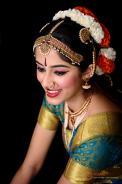Contribute
| Arangetram: Ashya Singh |
Neeraja Deshpande
08/10/2016
Elegance, poise, and an overall feeling of divinity graced Nashua South High School’s auditorium on July 30th, as Ashya Singh took the stage for her Bharatanatyam arangetram. The word “Bharatanatyam†is perhaps best at explaining the essence of the art form, with “bha†standing for “bhava†which translates to emotions, “ra†for “raga,†meaning music, “ta†for tala, or beat, and “natyam†for dance. The Bharatanatyam arangetram is a two thousand year old classical tradition demonstrating a dancer’s mastery of these three elements. To do so is not an easy feat for any dancer, so Ashya’s ability to do so is truly commendable. Ashya, a rising junior at Westford Academy, has been learning Bharatanatyam for eleven years and has studied it for seven years under Guru Ranjani Saigal. After completing her arangetram, she wants to continue dancing and choreographing. On top of this, she is passionate about community service, and has worked with organizations such as Vision-Aid, and is the treasurer of her school’s UNICEF club. Along with this, she regularly mentors children and does fundraising walks. It is in this charitable spirit of her’s that she generously asked the audience to donate to Ekal Vidyalaya in lieu of gifts, to support its mission in building and sustaining schools in rural India for children who usually have little to no access to education. One of the major parts of any arangetram is the musicians; at Ashya’s arangetram, the five lit up the auditorium with their music. Guru Smt. Ranjani Saigal was on the nattuvangam, Sri Babu Parameswaran provided the vocals, Sri Prabhu Sriram was on the mridangam, Sri Shenoi Prasanth Pandureng played the violin, and Sri Oruganti Rajashekhar was the flautist for the performance. After starting off with a prayer, the musicians played the Pushpanjali, in ragam Hamsadhwani and Adi talam. The Pushpanjali is traditionally the first dance, and is “an offering of flowers†where Ashya entered the stage and offered real flowers to the Nataraja murti, and took blessings from the musicians and the audience. This was immediately followed by Saint Tulsidas’ Ganesh Vandana, a Hindi bhajan praising Lord Ganesha. The Jathiswaram, in ragam Ragamalika and Mishrachapu talam followed the Ganesh Vandana. The pure dance piece has no meaning or story, just physical dance movements, which is exhausting for the dancer to perform; looking at Ashya’s polished performance, it was easy to think momentarily, that it was easy. Following this was the Ashtalakshmi Stotram, in ragam Ragamalika and Adi talam, a piece dedicated to the eight forms of wealth Goddess Lakshmi represents: heritage, food, courage, nature, children, victory, knowledge and material wealth. Her rendition, with the complex hand motions she so beautifully performed combined with the music, beautifully expressed Goddess Lakshmi’s divinity. After the Ashtalakshmi Stotram was the Varnam, which is the most challenging and complicated piece in a Bharatanatyam performance, combining nritta (pure dance) and abhinaya (expression) to tell a story. Her Varnam, composed by Papanasam Sivan in ragam Nattakurinji and Adi talam, is dedicated to Lord Shiva, where the poet sees himself as a slave to the Lord, and asks the Lord to come without delay and protect him. In her sancharas (a part of the Varnam without any lyrics where the dancer tells a story), Ashya expertly captured anger and devotion and joy within minutes, even seconds of each other, adding color and life to the touching stories she portrayed. Composed by Madurai N. Krishnan in ragam Revathy and Adi talam, Ashya danced to Durge Durge, to honor Mother Goddess Durga, characterizing her as compassionate through the blessings she gives to her devotees with her thousand names and thousand eyes. After this piece was Kunjan Ban Chaadi, by Saint Meera Bai, in Adi talam. The bhakti, or devotion, in the lyrics of this piece was evident in the sheer amount of feeling Ashya poured into her dance. Jatayu Moksha, composed by Saint Tulsidas in Adi talam, accompanied Kunjan Ban Chaadi. In this piece, verses from the Ramcharitmanas tell the story of the killing of Maricha, Sita Haran, and the war between Ravana and Jatayu, where the latter is fatally injured trying to save Sita. Then, Jatayu meets Sri Rama for the last time, when he attains Moksha. One minute, Ashya was Ravana, angry and deadly, injuring Jatayu, and the next, she was Jatayu, on the floor hurting and in pain from his wound, again, expertly weaving the emotions displayed in the story to create something touching and divine. As a final piece before the Mangalam, Ashya performed the Tarangam, a Kuchipudi style dance, in Ragam Atana and Adi Talam, composed by Oothukadu Venkatasubbaaiyer. Here, Ashya danced to the poet’s description of the beauty of Lord Krishna and His dance on the head of Kalinga, before pulling out a brass plate and doing complex jatis on it. Immediately following this, she performed her Mangalam, and expressed her gratitude to God, the musicians, and the audience for her success, ending in the audience giving her a well deserved standing ovation.
Congratulations to Ashya, her parents, Supriya and Pankaj Singh, her sister, Avashya, and her Guru, Ranjani Saigal. After performing a truly exquisite job, she has so much to be proud of, and I hope she continues to channel her talents and the skills she has developed both towards dance and towards everything else she does in life.
You may also access this article through our web-site http://www.lokvani.com/
